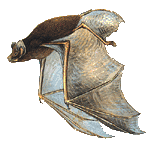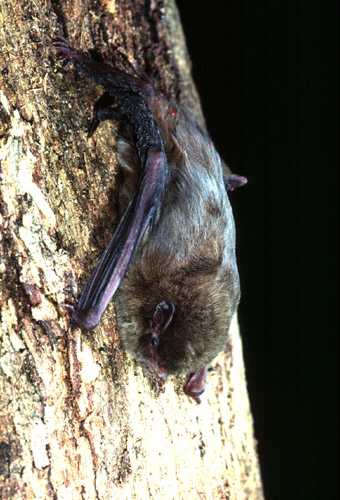 Article from the newsletter of the Friends of the ANBG, June 2000
Article from the newsletter of the Friends of the ANBG, June 2000
Bat hotel receives first guest
Bat boxes placed on trees in the Gardens have received their first guest - a male Chocolate Wattled Bat, Chalinolobus morio. Bat researchers Narelle Montgomery and Barry Baker of the Australian Bird and Bat Banding Scheme (ABBBS) found the bat at home when they recently inspected the boxes. Although it became evident six months ago that bats had commenced using the boxes because of the presence of bat droppings in a few boxes, this is the first time that a bat has been found in one of the boxes.
The ABBBS commenced a long-term ecological study of bats in the Botanic Gardens in Autumn 1998 by erecting 40 bat boxes throughout the ANBG. Two designs were used - a box measuring approximately 30 by 12 by 12 cm with a small slit entrance on the underside, and another design which is essentially a piece of corrugated iron fixed to a board. The first design simulates tree hollows, whilst the other design provides a roosting site which resembles exfoliating bark. Both these types of situations are typical day-roosting sites for small insectivorous bats.
 Chocolate Wattled Bat |
Ecological studies of insectivorous bats are difficult to conduct because bats are cryptic and roost in inaccessible places such as small hollows in trees. Most studies carried out in Australia to date have therefore been short-term or required the destruction of roost sites to examine roosting and breeding associations.
In order to carry out long-term studies, it is therefore necessary to either locate existing colonies of bats which are accessible, or encourage animals to colonise accessible sites such as artificial roost boxes. The latter course of action has greater feasibility, and also leads to the provision of additional habitat for bats.
The boxes were constructed by ANBG ranger John Jervis to a specification which has proven to be effective at the Organ Pipes National Park in Victoria. Based on previous experience at Organ Pipes National Park, it was expected that habitation of the boxes could take up to two to three years. Narelle and Barry were therefore very pleased to record their first guest so early in the proceedings.
It is difficult to predict which species of bats will occupy the boxes at this stage, but the box design should suit at least seven species known to occur in the ANBG. These species are:
| Chocolate Wattled Bat | Chalinolobus morio |
| Gould's Wattled Bat | Chalinolobus gouldii |
| Little Forest Bat | Vespadelus vulturnus |
| Southern Forest Bat | Vespadelus regulus |
| Large Forest Bat | Vespadelus darlingtoni |
| Lesser Long-eared Bat | Nyctophilus geoffroyi |
| Gould's Long-eared Bat | Nyctophilus gouldi |
Bats are common residents of the Gardens. During a recent hot February night Barry and Narelle set up two harp traps around the pond below Hudsons Cafe. They caught a total of 26 bats comprising five of the above species (two wattled and three forest bat species). The bats were all banded with a small metal wing tag and released. It is hoped that they will soon be found again, but this time roosting in the bat boxes.
Chocolate Wattled Bat: Illustration by Neville Cayley.
![Director of National Parks [logo]](../../../../../images/dnp_90px.gif)

